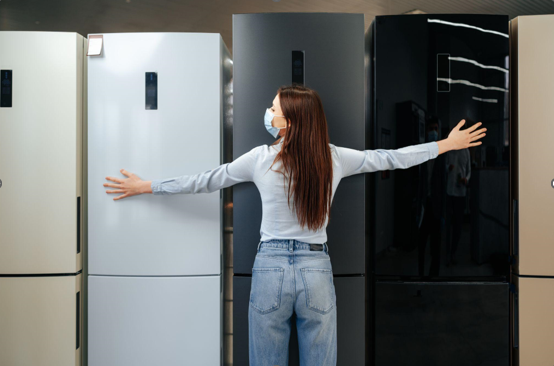Refrigerators: From Ice Boxes To Smart, Energy-Efficient Appliances

Are you longing for an ice-cold drink on a sweltering day or perhaps seeking the perfect temperature to store fresh groceries? You don’t need to be a whiz to figure out the crucial role the humble refrigerator plays in our daily lives. It’s hard to imagine when we didn’t have this versatile appliance. A large refrigerator for home is often the centerpiece of the kitchen, a cornerstone of modern life. But how did we get here? This article will take you through the intriguing journey of the refrigerator, from basic ice boxes to today’s smart, energy-efficient models.
Evolution of The Refrigerators: From Ice Boxes to Energy-efficient Application
Let us try to understand the evolution of refrigerators, right from ice boxes to energy-efficient applications.
The Humble Beginnings: Ice Boxes
Back in the days before electric refrigeration, ice boxes were the primary means of preserving food. These rudimentary appliances were essentially insulated boxes—often made from wood and lined with zinc, tin, or cork. A large block of ice was stored in the top compartment. Also, the cool air filtered down, preserving the perishable food items in the lower compartments.
Ice for these boxes was typically harvested from lakes and rivers during winter and stored in ice houses. As you can imagine, this process was labor-intensive, expensive, and far from ideal in warmer climates. The ice box represented a critical leap forward in food preservation but was only a small taste of what was to come.
The Birth Of Mechanical Refrigeration
The 20th century marked the advent of mechanical refrigeration. Early models were far from perfect, often large, noisy, and dangerous. However, inventors and engineers tirelessly worked on improving these designs. By the mid-20th century, refrigerators started to resemble the models we’re familiar with today—quiet, compact, and, most importantly, safe.
These modern refrigerators utilize a refrigeration cycle, a process that involves a refrigerant—a substance with a shallow boiling point. The refrigerant circulates in a closed loop, absorbing heat from the inside of the fridge and releasing it on the outside.
This simple yet ingenious design revolutionized food storage and paved the way for the next era of refrigeration technology.
Energy Efficiency: A Growing Concern
With the energy crisis of the 1970s, there was a push to make appliances more energy efficient. Governments worldwide implemented energy-efficiency standards, and manufacturers quickly responded with improved designs and technology.
Today, refrigerators are remarkably efficient compared to their counterparts from a few decades ago. Features such as improved insulation, more efficient compressors, and better door seals contribute to reduced energy consumption.
Furthermore, many modern fridges carry energy efficiency ratings, allowing consumers to make an informed choice when purchasing a new appliance.
Welcome To The Future: Smart Refrigerators
In the age of smart technology, even our fridges haven’t escaped the revolution. Smart refrigerators are the latest trend in kitchen appliances, offering various features to make our lives easier.
Smart fridges connect to your home’s Wi-Fi network, allowing you to interact with them via a smartphone app. Features include temperature control, tracking energy usage, and inventory management.
Some models even have built-in cameras, so you can check what’s in your fridge without opening the door—a handy feature for those quick grocery store trips!
The Quest For Sustainability
While smart features are undoubtedly convenient, they’re also paving the way for a more sustainable future. Internet of Things (IoT) enabled refrigerators can intelligently manage energy consumption, reducing their environmental impact.
Some models can even communicate with the grid to identify the most energy-efficient running times, further contributing to a greener planet.
Key Technology Thats Inducted In Modern Refrigerators
This section discusses some of the great applications of technology in modern refrigerators.
Longer Lasting Ice Cubes
One of the best applications of the refrigerator is undoubtedly the long-lasting ice cubes, thats for sure. The ice maker, without question, is the best feature that you look for in a good refrigerator. It is a dire need, especially in the scorching heat of the summer.
You all have heard about the squarish-shaped ice cubes. But what about the spherical ice cubes? They actually melt much slower and take quite a longer time.
Blue Light Crispers
Another technology that has performed well in recent times is blue crispers. The ultimate aim or, say, this technology’s objective is to make fruits and vegetables last longer. The traditional crispers with blue light display persistent photosynthesis in your fresh produce. It ensures that you have the nutrients and other constituents well preserved.
WIFI Connectivity
The possibilities are indeed ceaseless with that of the smart refrigerator. The capabilities may vary across the brand and the models. With the help of smart features, you can remotely monitor the fridge’s contents.
You can keep track of the date of expiration. Apart from this, you have some other key technological development that has indeed brought a change.
Edge To Edge Selve
Depletion of space is a problem in the present time. This is not uncommon inside your refrigerator. Yes, you got it right; the edge-to-edge self is one of the core characteristics of your fridge. It allows you to have more space. Most significantly, you do not really have to compromise with your fridge’s menu.
Knock To View
Some of the modern refrigerators like Samsung offer you to see inside through the cameras. On the other hand, you will be able to see the chapped favorites with one knock on the door. While you knock, it will illuminate and you can see inside. Hence you do not have to open the fridge to see your favorite food.
Ultimately your fridge will be much more efficient in turns of the use of power. Technology is going through great changes, and refrigerators are not an exception, to say the least. Hence, make the best use of the technology that is available to you.
Conclusion
From the humble ice box to today’s smart, energy-efficient refrigerators, it’s clear that this indispensable household appliance has come a long way. The journey reflects our relentless quest for convenience, efficiency, and sustainability.
With the integration of smart technologies and a continuous focus on energy efficiency, the evolution of the refrigerator is far from over. The refrigerator’s story is a testament to human ingenuity and will continue to unfold as we step into the future.
Additionals:


























